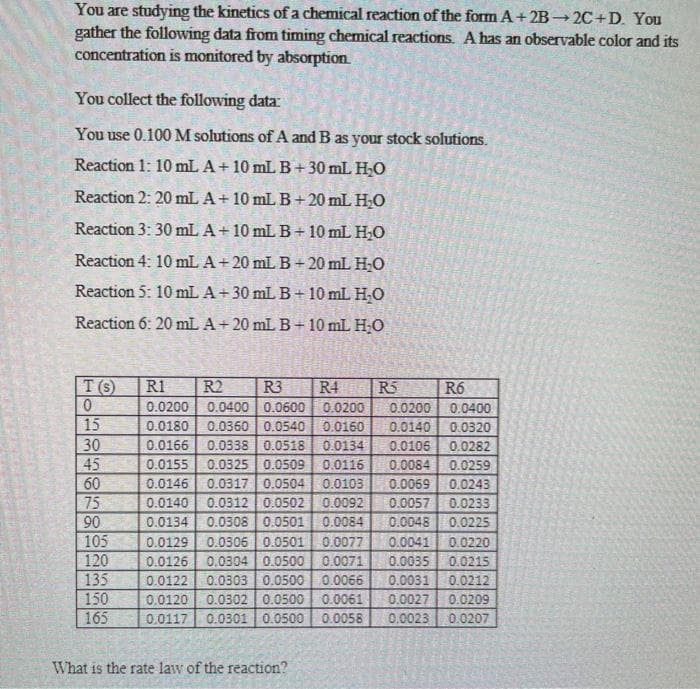You are studying the kinetics ofa chemical reaction of the form A+2B 2C+D. You gather the following data from timing chemical reactions. A has an observable color and its concentration is monitored by absorption. You collect the following data: You use 0.100 M solutions of A and B as your stock solutions. Reaction 1: 10 mL A+ 10 mL B+30 mL H,O Reaction 2: 20 mL A+ 10 mL B+20 mL H;O Reaction 3: 30 mL A+ 10 mL B+ 10 mL HO Reaction 4: 10 mL A+ 20 mL B-20 mL H;O Reaction 5: 10 mL A+30 mL B+ 10 mL H-O Reaction 6: 20 mL A+ 20 mL B-10 mL H;O T(S) R1 R2 R3 R4 R5 R6 0.0200 0.0400 0.0600 0.0200 0.0200 0.0400 15 0.0180 0.0360 0.0540 0.0160 0.0140 0.0320 30 0.0166 0.0338 | 0.0518 0.0134 0.0106 0.0282 45 60 75 90 105 0.0155 0.0325 0.0509 0.0116 0.0084 0.0259 0.0146 0.0317 0.0504 0.0103 0.0069 0.0243 0.0312 0.0502 0.0308 0.0501 0.0306 0.0501 0.0304 0.0500 0.0071 0.0303 0.0500 | 0.0066 0.0140 0.0092 0.0057 0.0233 0.0134 0.0084 0.0048 0.0225 0.0129 0.0077 0.0041 0.0220 120 135 150 165 0.0126 0.0035 0.0215 0.0122 0.0031 0.0212 0.0120 0.0302 0.0500 0.0061 0.0027 0.0209 0.0117 0.0301 0.0500 0.0058 0.0023 0.0207 What is the rate law of the reaction?
You are studying the kinetics ofa chemical reaction of the form A+2B 2C+D. You gather the following data from timing chemical reactions. A has an observable color and its concentration is monitored by absorption. You collect the following data: You use 0.100 M solutions of A and B as your stock solutions. Reaction 1: 10 mL A+ 10 mL B+30 mL H,O Reaction 2: 20 mL A+ 10 mL B+20 mL H;O Reaction 3: 30 mL A+ 10 mL B+ 10 mL HO Reaction 4: 10 mL A+ 20 mL B-20 mL H;O Reaction 5: 10 mL A+30 mL B+ 10 mL H-O Reaction 6: 20 mL A+ 20 mL B-10 mL H;O T(S) R1 R2 R3 R4 R5 R6 0.0200 0.0400 0.0600 0.0200 0.0200 0.0400 15 0.0180 0.0360 0.0540 0.0160 0.0140 0.0320 30 0.0166 0.0338 | 0.0518 0.0134 0.0106 0.0282 45 60 75 90 105 0.0155 0.0325 0.0509 0.0116 0.0084 0.0259 0.0146 0.0317 0.0504 0.0103 0.0069 0.0243 0.0312 0.0502 0.0308 0.0501 0.0306 0.0501 0.0304 0.0500 0.0071 0.0303 0.0500 | 0.0066 0.0140 0.0092 0.0057 0.0233 0.0134 0.0084 0.0048 0.0225 0.0129 0.0077 0.0041 0.0220 120 135 150 165 0.0126 0.0035 0.0215 0.0122 0.0031 0.0212 0.0120 0.0302 0.0500 0.0061 0.0027 0.0209 0.0117 0.0301 0.0500 0.0058 0.0023 0.0207 What is the rate law of the reaction?
Chemistry & Chemical Reactivity
9th Edition
ISBN:9781133949640
Author:John C. Kotz, Paul M. Treichel, John Townsend, David Treichel
Publisher:John C. Kotz, Paul M. Treichel, John Townsend, David Treichel
Chapter14: Chemical Kinetics: The Rates Of Chemical Reactions
Section: Chapter Questions
Problem 86IL: The acid-catalyzed iodination of acetone CH3COCH3(aq) + I2(aq) CH3COCH2I(aq) + HI(aq) is a common...
Related questions
Question

Transcribed Image Text:You are studying the kinetics ofa chemical reaction of the form A+2B 2C+D. You
gather the following data from timing chemical reactions. A has an observable color and its
concentration is monitored by absorption.
You collect the following data:
You use 0.100 M solutions of A and B as your stock solutions.
Reaction 1: 10 mL A+ 10 mL B+30 mL H,O
Reaction 2: 20 mL A+ 10 mL B+20 mL HO
Reaction 3: 30 mL A+ 10 mL B+10 mL H;O
Reaction 4: 10 mL A+ 20 mLB 20 mL H,O
Reaction 5: 10 mL A+30 mL B+ 10 mL H,O
Reaction 6: 20 mL A+ 20 mL B 10 mL H;O
T(s)
R1
R2
R3
0.0400 | 0.0600 0.0200
R4 R5
R6
0.0200
0.0200
0.0400
15
0.0180
0.0360 0.0540 0.0160
0.0140
0.0320
0.0338 0.0518
0.0325 0.0509 0.0116
0.0317 | 0.0504
0.0140 0.0312 0.0502 0.0092
0.0134 0.0308 0.0501
0.0129 0.0306 0.0501 0.0077
0.0304 0.0500 0.0071
0.0122 0.0303 0.0500 | 0.0066
0.0120 0.0302 0.0500
0.0117 0.0301 0.0500| 0.0058
30
0.0166
0.0134
0.0106
0.0282
45
60
75
90
0.0155
0.0084
0.0259
0.0146
0.0103
0.0069
0.0243
0.0057
0.0048
0.0233
0.0084
0.0225
105
120
135
0.0041
0.0220
0.0126
0.0035
0.0215
0.0031
0.0212
150
0.0061
0.0027
0.0209
165
0.0023
0.0207
What is the rate law of the reaction?
Expert Solution
This question has been solved!
Explore an expertly crafted, step-by-step solution for a thorough understanding of key concepts.
Step by step
Solved in 3 steps with 3 images

Knowledge Booster
Learn more about
Need a deep-dive on the concept behind this application? Look no further. Learn more about this topic, chemistry and related others by exploring similar questions and additional content below.Recommended textbooks for you

Chemistry & Chemical Reactivity
Chemistry
ISBN:
9781133949640
Author:
John C. Kotz, Paul M. Treichel, John Townsend, David Treichel
Publisher:
Cengage Learning

Chemistry & Chemical Reactivity
Chemistry
ISBN:
9781337399074
Author:
John C. Kotz, Paul M. Treichel, John Townsend, David Treichel
Publisher:
Cengage Learning

Chemistry for Engineering Students
Chemistry
ISBN:
9781337398909
Author:
Lawrence S. Brown, Tom Holme
Publisher:
Cengage Learning

Chemistry & Chemical Reactivity
Chemistry
ISBN:
9781133949640
Author:
John C. Kotz, Paul M. Treichel, John Townsend, David Treichel
Publisher:
Cengage Learning

Chemistry & Chemical Reactivity
Chemistry
ISBN:
9781337399074
Author:
John C. Kotz, Paul M. Treichel, John Townsend, David Treichel
Publisher:
Cengage Learning

Chemistry for Engineering Students
Chemistry
ISBN:
9781337398909
Author:
Lawrence S. Brown, Tom Holme
Publisher:
Cengage Learning